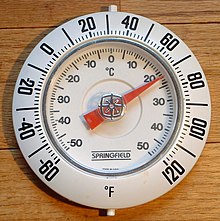
Back Fahrenheit Afrikaans Grau Fahrenheit AN فهرنهايت Arabic ফাৰেনহাইট Assamese Grau Fahrenheit AST Farenheyt şkalası Azerbaijani فارنهایت AZB Fahrenheit BCL Градус Фарэнгейта Byelorussian Градус Фарэнгайта BE-X-OLD
| Fahrenheit | |
|---|---|
 Thermometer with Fahrenheit (marked on outer bezel) and Celsius (marked on inner dial) degree units. | |
| General information | |
| Unit system | Imperial/US customary |
| Unit of | Temperature |
| Symbol | °F |
| Named after | Daniel Gabriel Fahrenheit |
| Conversions | |
| x °F in ... | ... corresponds to ... |
| SI base units | 5/9(x +459.67) K |
| SI derived units | 5/9(x − 32) °C |
| Imperial/US absolute scale | x + 459.67 °Ra |
The Fahrenheit scale (/ˈfærənˌhaɪt, ˈfɑːr-/) is a temperature scale based on one proposed in 1724 by the European physicist Daniel Gabriel Fahrenheit (1686–1736).[1] It uses the degree Fahrenheit (symbol: °F) as the unit. Several accounts of how he originally defined his scale exist, but the original paper suggests the lower defining point, 0 °F, was established as the freezing temperature of a solution of brine made from a mixture of water, ice, and ammonium chloride (a salt).[2][3] The other limit established was his best estimate of the average human body temperature, originally set at 90 °F, then 96 °F (about 2.6 °F less than the modern value due to a later redefinition of the scale).[2]
For much of the 20th century, the Fahrenheit scale was defined by two fixed points with a 180 °F separation: the temperature at which pure water freezes was defined as 32 °F and the boiling point of water was defined to be 212 °F, both at sea level and under standard atmospheric pressure. It is now formally defined using the Kelvin scale.[4][5]
It continues to be officially used in the United States (including its unincorporated territories), its freely associated states in the Western Pacific (Palau, the Federated States of Micronesia and the Marshall Islands), the Cayman Islands, and Liberia.
Fahrenheit is commonly still used alongside the Celsius scale in other countries that use the U.S. metrological service, such as Antigua and Barbuda, Saint Kitts and Nevis, the Bahamas, and Belize. A handful of British Overseas Territories, including the Virgin Islands, Montserrat, Anguilla, and Bermuda, also still use both scales.[6] All other countries now use Celsius ("centigrade" until 1948), which was invented 18 years after the Fahrenheit scale.[7]
Though the United Kingdom changed from Fahrenheit to Celsius in metrology, Fahrenheit is sometimes still used in newspaper headlines to sensationalise heatwaves.[8]
- ^ Balmer, Robert T. (2010). Modern Engineering Thermodynamics. Academic Press. p. 9. ISBN 978-0-12-374996-3. Retrieved 17 July 2011.
- ^ a b "Fahrenheit temperature scale". Encyclopædia Britannica Online. Retrieved 25 September 2015.
- ^ "Fahrenheit: Facts, History & Conversion Formulas". Live Science. Retrieved 9 February 2018.
- ^ Benham, Elizabeth (6 October 2020). "Busting Myths about the Metric System". US National Institute of Standards and Technology (NIST).
- ^ "Appendix C – General Tables of Units of Measurement" (PDF). NIST Handbook 44 -Specifications, Tolerances, and Other Technical Requirements for Weighing and Measuring Devices - 2022. US National Institute of Standards and Technology (NIST). 29 November 2021. Archived (PDF) from the original on 27 December 2021.
- ^ "50 years of Celsius weather forecasts – time to kill off Fahrenheit for good? | Metric Views". Archived from the original on 2 October 2020. Retrieved 28 July 2019.
- ^ Celsius, Anders (1742) "Observationer om twänne beständiga grader på en thermometer" (Observations about two stable degrees on a thermometer), Kungliga Svenska Vetenskapsakademiens Handlingar (Proceedings of the Royal Swedish Academy of Sciences), 3: 171–180 and Fig. 1.
- ^ Barba, Vassia (14 July 2023). "Earth's hottest ever temperature of 131F to be recorded this weekend". The Mirror. Retrieved 24 October 2023.
© MMXXIII Rich X Search. We shall prevail. All rights reserved. Rich X Search